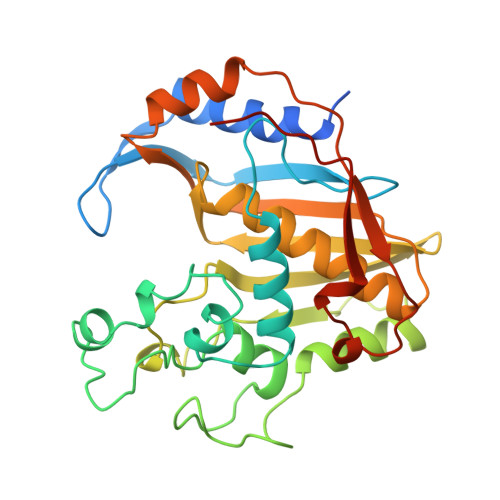Crystal structures of rat thymidylate synthase inhibited by Tomudex, a potent anticancer drug.
Sotelo-Mundo, R.R., Ciesla, J., Dzik, J.M., Rode, W., Maley, F., Maley, G.F., Hardy, L.W., Montfort, W.R.(1999) Biochemistry 38: 1087-1094
- PubMed: 9894005
- DOI: https://doi.org/10.1021/bi981881d
- Primary Citation of Related Structures:
1RTS, 2TSR - PubMed Abstract:
Two crystal structures of rat thymidylate synthase (TS) complexed with dUMP and the anticancer drug Tomudex (ZD1694) have been determined to resolutions of 3.3 and 2.6 A. Tomudex is one of several new antifolates targeted to TS and the first to be approved for clinical use. The structures represent the first views of any mammalian TS bound to ligands and suggest that the rat protein undergoes a ligand-induced conformational change similar to that of the Escherichia coli protein. Surprisingly, Tomudex does not induce the "closed" conformation in rat TS that is seen on binding to E. coli TS, resulting in inhibitor atoms that differ in position by more than 1.5 A. Several species-specific differences in sequence may be the reason for this. Phe 74 shifts to a new position in the rat complex and is in van der Waals contact with the inhibitor, while in the E. coli protein the equivalent amino acid (His 51) hydrogen bonds to the glutamate portion of the inhibitor. Amino acids Arg 101, Asn 106, and Met 305 make no contacts with the inhibitor in the open conformation, unlike the equivalent residues in the E. coli protein (Thr 78, Trp 83, and Val 262). dUMP binding is similar in both proteins, except that there is no covalent adduct to the active site cysteine (Cys 189) in the rat structures. Two insertions in the rat protein are clearly seen, but the N-termini (residues 1-20) and C-termini (residues 301-307) are disordered in both crystal forms.
- Department of Biochemistry, University of Arizona, Tucson 85721, USA.
Organizational Affiliation:


















